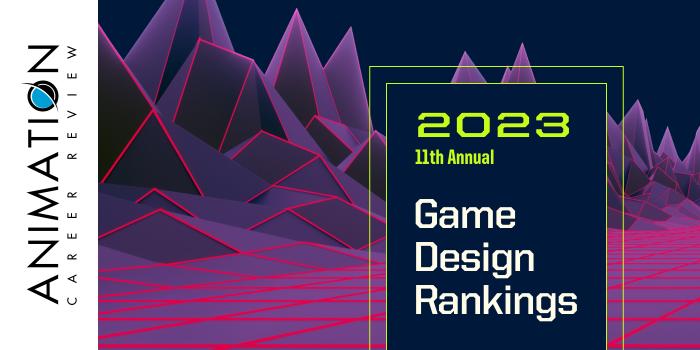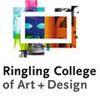

What are the top private game design schools in the U.S. for 2023?
| Ranking | School | % of Schools Considered |
|---|---|---|
| 1 | University of Southern California | Top 1% |
| 2 | Carnegie Mellon University | Top 3% |
| 3 | New York University | Top 4% |
| 4 | Rochester Institute of Technology | Top 5% |
| 5 | Full Sail University | Top 6% |
| 6 | Savannah College of Art and Design | Top 8% |
| 7 | DigiPen Institute of Technology | Top 9% |
| 8 | DePaul University | Top 10% |
| 9 | Massachusetts Institute of Technology | Top 15% |
| 10 | Southern Methodist University | Top 15% |
| 11 | Drexel University | Top 15% |
| 12 | Gnomon School of Visual Effects | Top 15% |
| 13 | Ringling College of Art and Design | Top 20% |
| 14 | Rensselaer Polytechnic Institute | Top 20% |
| 15 | Champlain College | Top 20% |
| 16 | Worcester Polytechnic Institute | Top 20% |
| 17 | The New School's Parsons School of Design | Top 25% |
| 18 | Northeastern University | Top 25% |
| 19 | Laguna College of Art and Design | Top 25% |
| 20 | Academy of Art University | Top 25% |
| 21 | Columbia College Chicago | Top 30% |
| 22 | University of Pennsylvania | Top 30% |
| 23 | Cornell University | Top 30% |
| 24 | American University | Top 30% |
| 25 | University of Denver | Top 35% |
Our 2023 rankings of the Top 25 Private Game Design School Programs in the US. For an explanation of ranking criteria, click here.

University of Southern California (USC) has launched two new programs for the 2022-2023 school year. Housed in the School of Cinematic Arts (SCA) is the new Game Art BFA, which provides the opportunity to specialize in areas such as Character Animation, Visual Effects (VFX), Interactive Animation, 3D Pipelines, or Environmental Design.
Consisting of 128 units, the new cross-disciplinary Game Art BFA features 52 units in the major, five workshop courses, the opportunity to select six elective credits in areas from character rigging to Python, and an Advanced Game Project (AGP). Completed in teams across two courses, the AGP culminates with a functional digital game suitable for distribution via the web and/or submission into independent games festivals.
Housed in Viterbi School of Engineering, the new Technical Game Art (TGA) Minor is part of the Information Technology Program (ITP). Students in the program will complete 16 units of study, several projects, and courses such as 3D Character Modeling for Games, Technical Character Animation for Games, and 3D Modeling, Animation, and Visual Effects (VFX). Elective examples include Accelerated Programming in Python and 3D Computer Animation.
In addition to two new programs for students interested in pursuing game studies, University of Southern California houses USC Games—a collection of minors and multiple degree programs leading to a BA, BFA, BS, MFA or MS. Programs are part of SCA’s Interactive Media and Games Division and the Department of Computer Science at Viterbi School of Engineering.
The USC Games Program combines the study of art, design, engineering, and production. Classes are collaborative, immersive, and hands on, allowing students to develop team-building skills and expertise in every area of game design and development. Courses are taught by working professionals in the field.
Specific degrees include an Interactive Entertainment BA, a Game Development and Interactive Design BFA, a Computer Science BS (Games), MFAs in Interactive Media (Games and Interactive Entertainment) and Interactive Media (Games and Health), a Game Design and Development MS, and a Computer Science MS with a Game Development Specialization. A Cinematic Art MA (Media Arts, Games and Health) is offered in conjunction with SCA, the Graduate School, and the Creative Media & Behavioral Health Center.
Minors within the USC Games Program are designed for students who would like to develop entry-level game design and development skills that can be utilized in interactive media, animation, games, film/television, and other areas. Course examples include Game Design, Game Animation, Game Studies, Video Game Design and Management, Game Audio, Game Entrepreneurism, Video Game Programming, Game User Research, Video Game Production, 3D Computer Modeling and Graphics, Computer Science, and Themed Entertainment.
Graduates of USC Games have developed and sold their own games, launched their own studios, or landed positions at major studios such as Riot Games, Disney, Epic Games, Apple, ESPN, and CBS interactive.
Established in 1880, University of Southern California (USC) employs more than 28,100 people making it the largest private sector employer in Los Angeles. Serving 49,500 students across 23 schools and divisions, USC is also one of the largest research universities in the U.S. More than 600 graduate and professional programs are offered, including one of the best film programs in the nation. USC is the only university to have an alum nominated for an Oscar every year since the Academy Awards’ inception in 1929.
The University of Southern California is accredited by the Western Association of Schools and Colleges (WASC) Senior College and University Commission (WSCUC).

The Entertainment Technology Center (ETC) at Carnegie Mellon University (CMU) was established in 1998. A partnership between CMU’s College of Fine Arts and the School of Computer Science (CS), the ETC houses the Master’s in Entertainment Technology (MET) and the Game Design Minor in collaboration with the Integrative Design, Arts, and Technology Network (IDeATe).
The MET is a terminal degree that takes two years to complete. The program explores Building Virtual Worlds, Improvisational Acting, Fundamentals of Entertainment Technology, and Visual Story. Students will have the opportunity to select electives from the following areas: Game Design, Interactive Storytelling, Themed Entertainment, Leadership & Innovation, and General. Possible elective options include Game Design, Game Design, Prototyping and Production, Understanding Game Engines, Dynamic Motion and Game Experience, Advanced Pipeline Topics for Film and Game Art, IDeATe: Little Games/Big Stories: Indie Roleplaying Game, Story Development and Previsualization in AI, and Advanced Game Studio.
The ETC IDeATe Game Design Minor at Carnegie Mellon University is open to all majors (the school has more than 7,000 major/minor combo options). Popular combo options for game designers include the Art BFA/Game Design Minor, CS BS/Game Design Minor, the Bachelor of Computer Science and Arts (BCSA)/Game Design Minor, and the Music and Technology BS/Game Design Minor. The CMU ETC also allows students across all departments to enroll in individual courses to enhance their program of study.
The ETC IDeATe Game Design Minor consists of courses that cover topics such as game programming, game systems and mechanics design, Interactive narrative and character development, user testing, computing, interface design, visual and audio design, the design process, and teamwork. The ETC IDeATe Game Design Minor requires a minimum of 45 units of study to complete the program.
Carnegie Mellon University graduates are routinely hired by companies and studios such as Amazon, Epic Systems, Apple, Google, Microsoft, ESPN, IBM, Meta, 2K Games, and 31st Street Studios.
Founded in 1900 by industrialist and philanthropist Andrew Carnegie, Carnegie Mellon University began as Carnegie Technical Schools. Today, the school serves around 15,800 students enrolled in more than 200 programs across seven colleges and schools. CMU also has more than a dozen degree-granting locations, and over 20 research partnerships in Silicon Valley, Australia, Africa, and Qatar. A private, global research university, Carnegie Mellon University is accredited by the Middle States Commission on Higher Education (MSCHE).

The Game Center is the Department of Game Design at New York University’s (NYU) Tisch School of the Arts. Founded in 2008, The NYU Game Center hosts events and programs such as the NYU Game Center Lecture Series, No Quarter Exhibition (est. 2010), and the professional game conference known as PRACTICE: Game Design in Detail. The Center, which also hosts workshops, playtests, and tournaments, has two degree options—the Game Design BFA and MFA. A Games Minor is also available as well as a wide variety of courses for NYU students who might be interested in games.
The Game Minor consists of 18 credit hours of study and it explores foundation game studies and other areas through elective coursework. Graduate students will complete a thesis project to be presented at the NYU Game Center Spring Show.
All programs at the NYU Game Center consist of immersive academic seminars and hands-on experiences in the Center’s development studios and play labs. Students may focus on programming, design, or visual design for games, game criticism, game art, or other areas.
A major component of the NYU Game Center is the internship program. Students have completed internships with Disney, Ubisoft, Arkadium, and TreSensa. NYU Game Center graduates will leave the program with a resume and several finished games.
New York University Game Center alumni are Game Artists, Game Designers and Developers, Software Publishers, AI Engineers, and Entrepreneurs. They work at companies and studios such as Blizzard Entertainment, Riot Games, Amazon, Tencent, Take-Two Interactive, ESPN, Nickelodeon, and IGDA Japan.
New York University was founded in 1831. Serving nearly 55,000 students, NYU is one of the nation’s largest private universities. In addition to the New York campus, NYU has campuses in Abu Dhabi and Shanghai, along with 11 global academic centers in Asia, Europe, Africa, North America, and South America. With an estimated 400+ programs, New York University is accredited by the Middle States Commission on Higher Education (MSCHE).
Founded in 1965, Tisch School of Arts at New York University serves more than 4,000 students from 48 states and 39 countries. Programs are offered at all degree levels through Maurice Kanbar Institute of Film & Television, the Institute of Performing Arts, and the Institute of Emerging Media.

Rochester Institute of Technology (RIT) has several paths to study game design. Within RIT’s B. Thomas Golisano College of Computing and Information Sciences (GCCIS) is the School of Interactive Games & Media (IGM), which has both BS and MS programs in Game Design and Development. An Accelerated BS/MS is also available. All programs explore animation, math and science, interactive media, modeling, user interaction, and of course, game design and development.
Course examples across programs include Games Balance, IGM Production Studio, Artificial Intelligence (AI) for Gameplay, Gameplay and Prototyping, Casual Game Development, Systems Concepts for Games and Media, Game Engine Design and Development, Console Development, Game Design and Development for Casual and Mobile Platforms, Game Development Processes, Level Design, and Physical Computing & Alternative Interfaces. Seminars, game development and research studios, and independent study are also part of the programs.
RIT IGM Game Design and Development students will also have the rare opportunity to complete two paid blocks of cooperative education, which will allow them to gain experience in the games industry through a full-time employment at a studio. Google, Cartoon Network, Electronic Arts (EA), Sony Interactive Entertainment, Epic Games, and Microsoft are just a few recent co-op companies. Students will also have the opportunity to develop and commodify their own games at RIT’s MAGIC Spell Studios.
Housed in the College of Art and Design is the School of Design, which has an additional option for students interested in studying games. The 3D Digital Design BFA includes courses such as Game Development and Algorithmic Problem Solving, Computer Science, Environment Design, Layers and Effects, and Modeling and Motion Strategies.
Rochester Institute of Technology is a top research university that dates back to 1829. With global campuses in China, Croatia, Dubai, and Kosovo, the school serves more than 19,000 students, making it one of the largest private universities in the U.S. RIT offers more than 200 academic programs across 11 colleges and institutes. Rochester Institute of Technology is accredited by the Middle States Commission on Higher Education (MSCHE).

Full Sail University is home to The Gaming School which houses production studios and classrooms that look and feel like major production studios. Degree options here include the Game Design BS and MS and BS degrees in Game Art, Game Development, Simulation & Visualization, and Game Business & Esports. Undergraduate Certificates in 3-D Arts, Game Design, and Game Business & Esports are also available. The Simulation & Visualization BS is offered on campus and all other programs are offered both on campus and online.
In addition to gaining production experience in a real-world studio environment on the Full Sail University campus, gaming students have opportunities to work off campus at local and national studios through the internship program. Courses in The Gaming School are also immersive. Course examples across all programs include Motion Capture, Game Mechanics, Game Production Tools, Engine Development, Artificial Intelligence (AI), and Data Visualization & Modeling. Students will master all roles in the production pipeline, video game development for computers, networks and consoles, test simulation, game effects, narrative design, and animation.
Full Sail University’s Career Development Department provides 24/7 access to job opportunities, along with workshops and presentations that cover branding, networking, research strategies, and interviewing techniques. The department also coordinates local hiring events and events in other major markets such as Los Angeles and New York.
Full Sail University graduates have worked on many popular games, films, and ad campaigns. Games include Call of Duty: Modern Warfare II, Overwatch 2, Horizon Forbidden West, Apex Legends, Destiny 2, and Fortnite. More than 200 graduates from Games, Art & Design, Music & Recording, Business, and Media & Communications areas were credited on over 25 projects nominated in 21 categories at The 2022 Game Awards.
Graduates from Game Design, Film, and Entertainment Business also contributed to winners in categories including Best Adaptation (Arcane: League of Legends), Best Esports Game (Valorant), Best VR/AR (Moss: Book II), Best Fighting (MultiVersus), and Games for Impact (As Dusk Falls).
Companies and studios that have hired Full Sail University graduates include Disney, Rockstar Games, Blizzard Entertainment, Industrial Light & Magic (ILM), Nickelodeon, Bunim Murray, Pixar, MTV, ESPN, Universal Studios, Miramax, DreamWorks, and HBO.
Full Sail University offers graduate certificates and programs at all degree levels in the Arts, Entertainment, Media, and Technology. The school, which opened in 1979 in Dayton, Ohio, is located just 35 minutes from downtown Orlando and Universal Studios. Serving approximately 21,000 students, Full Sail is accredited by the Accrediting Commission of Career Schools and Colleges (ACCSC).

The School of Digital Media at Savannah College of Art and Design (SCAD) has a number of pathways to study game design. Undergraduate options include a Digital Media BA with Game Development and Interactive Design Tracks, an Interactive Design and Game Development (IDGD) BFA, and Minors in Concept Design for Animation and Games, Game UX, Interactive Design and Game Development, Concept Art for Games, and Mobile and Interactive Design. At the graduate level, SCAD’s School of Digital Media has MA and MFA degrees in IDGD. Programs are offered at the Atlanta and Savannah campuses, as well online via SCADnow.
The School of Digital Media at SCAD provides opportunities for game design students to gain hands-on experience through internships with local and national studios. Students will also work individually and in teams to complete projects while utilizing state-of-the-art customized facilities at Montgomery Hall—a 130,000 square feet space consisting of studio classrooms, more than 800 computers, stop-motion sets, a green-screen stage, motion-capture technology, and AR/VR resources. The SCAD Digital Media Center in Atlanta provides an in-house theater, green screen lab, and a real-world studio environment.
Each quarter, students have the opportunity to interview and present their portfolios to professionals in the industry. Past visitors have been affiliated with studios such as Electronic Arts (EA), Zynga, and Activision Blizzard. Graduates of the IDGD Programs at Savannah College of Art and Design are routinely hired by these and other studios such as Epic Games, Firaxis Games, and Sucker Punch Productions.
Savannah College of Art and Design opened in the renovated Savannah Volunteer Guards Armory in September 1979. The school launched with just one classroom, an administration building, and 71 students. Today, SCAD serves more than 15,000 students across campuses in Atlanta and Savannah, Georgia, and Lacoste, France. With more than 100 degree programs and over 75 minors and certificate programs, Savannah College of Art and Design has more degree programs and specializations than any other art and design college in the U.S.
Savannah College of Art and Design is accredited by the Southern Association of Colleges and Schools Commission on Colleges (SACSCOC), the Council for Interior Design Accreditation (CIDA), and the National Architecture Accrediting Board (NAAB).

DigiPen Institute of Technology (DigiPen) was the first college in the world to offers a Bachelor’s degree in Video Game Technology and Development. The program has expanded to include BS degrees in Computer Science (CS) & Game Design and CS in Real-Time Interactive Simulation, and a Game Design BA.
A Digital Art MFA that allows students to customize a specialization is also available. The MFA requires a Final Thesis Project, consisting of a Professional Portfolio. MFA graduates are prepared to pursue careers in both Games and Animation.
Students in the DigiPen Game Design BA Program will explore interactive systems and game design, communications, user experience, and psychology. BS in Computer Science & Game Design students will study artificial intelligence (AI), system, level and technical design, user interface design, and programming languages.
CS/Real-Time Interactive Simulation BS students will master programming languages, game engine software, graphics rendering, artificial intelligence (AI), 2D and 3D simulation, graphical user interfaces (GUIs), and software engineering.
For exceptional students, DigiPen offers an accelerated BS/MS Program that can be completed in just five years. The BS in Computer Science in Real-Time Interactive Simulation degree program is accredited by the Computing Accreditation Commission of ABET.
Students in all programs will work in multidisciplinary teams in a studio environment to create software and a series of video games.
Graduates of all programs at DigiPen Institute of Technology enjoy a high job placement rate. To date, more than 600 companies have hired DigiPen graduates. A few examples include Epic Games, Electronic Arts (EA), Sony Interactive Entertainment, DreamWorks Interactive, Google, Amazon, Walt Disney Imagineering, SpaceX, Warner Bros. Interactive Entertainment, Microsoft, Activision, Insomniac Games, Zynga, Booz Allen Hamilton, Intel Corporation, Ubisoft Shanghai, Take-Two Interactive, ArenaNet, and Bungie, Inc.
DigiPen Institute of Technology was established in 1988 as a Vancouver, British Columbia-based computer simulation and animation company. The school serves around 1,200 students enrolled in 10 degree programs in Computer Science, Digital Art and Animation, Engineering, Game Design and Development, and Music and Audio.
DigiPen has international campuses in Singapore and Spain, and educational partnerships with Princess Nourah bint Abdul Rahman University in Riyadh, Kingdom of Saudi Arabia, Keimyung University in South Korea, The One Academy in Kuala Lumpur, Malaysia, and Thammasat University in Thailand.
DigiPen Institute of Technology is accredited by the Accrediting Commission of Career Schools and Colleges (ACCSC).

The Game Design Program at DePaul University (DePaul) is housed in the Jarvis College of Computing and Digital Media (CDM). Undergraduate pathways here include BS degrees in Game Design, Game Programming, and Computer Science (CS)/Game Systems. Graduate programs include a Game Design MFA and a Game Programming MS.
Game Design at DePaul University emphasizes collaboration and interdisciplinary learning. Design students will have opportunities to work with fine art, audio, programming, and writing students. The curriculum includes coursework that helps students navigate the game production process from inception to the testing phase. Course examples include Game Development, Practical Scripting for Games, Game Sound Design, 3D Design and Modeling, and Animation.
Students in all programs have access to the Virtual and Augmented Design Lab, the game studio known as DePaul Originals, and CDM facilities such as the gameplay, playtest and usability, XR, and game development and research labs. Other program benefits include participation in a variety of exhibitions, internship opportunities at local and national studios, and the biennial Japan Study Abroad Program. Students will graduate from the DePaul Game Design Program with a portfolio of their best works.
Some of the top careers for DePaul Game Design graduates include Game Design and Development, Animation, Computer Graphics, Software Engineering, Commercial Production, and Project Management. Program alumni have been hired at companies and studios such as Epic Games, Leo Burnett Worldwide, Fast Radius, iiRcade, and Speegs Media.
DePaul University provides exceptional academics and real-world experiences to prepare students for a changing world. With nearly 21,000 students across more than 300 academic programs, DePaul has two campus locations in Chicago. Students richly benefit from the city’s many opportunities. In turn, DePaul is one of the forces that shapes Chicago’s future. The university was founded in 1898 by the Congregation of the Mission (Vincentians), a Roman Catholic religious community dedicated to following the ideals of St. Vincent de Paul. DePaul is among the nation’s top universities for diversity because of its long tradition of providing a high-quality education to students from a broad range of backgrounds. DePaul is one of the largest private, nonprofit universities in the Midwest and one of the largest Catholic universities in the nation.

Massachusetts Institute of Technology (MIT) houses the MIT Game Lab, which helps students customize a plan of study to match their goals. The Lab is also a research and development hub that designs games for research.
Besides opportunities to customize their curriculum, students at MIT may study game design through several programs that allow students to choose a built-in “cluster” or electives from any department. Examples of programs that allow this much flexibility include Comparative Media Studies (CMS) and Computer Science and Engineering (CSE).
Housed in the School of Humanities, Arts, and Social Sciences (SHASS), the Department of Comparative Media Studies (CMS) provides programs leading to a BS or MS in CMS. The CMS Games and Interactive Media Cluster consists of more than 20 game design course options.
The Electrical Engineering & Computer Science Department in the MIT Schwarzman College of Computing (MIT EECS) is the largest department at MIT. EECS provides BS and MS degrees CSE. Programs are highly interdisciplinary and emphasize on-campus team and independent projects, lab work, research, and off-campus internships with MIT partner companies. Programs explore human-computer interaction (HCI) and graphics, artificial intelligence (AI), software engineering, programming languages, machine learning, algorithms and theory, and computer systems.
Elective requirements allow students to take additional courses that focus on games. Courses may be offered within and outside the department. Examples from the CMS Department include Game Design Methods, Videogame Theory, Interactive Narrative, Imagination, Computation & Expression Studio, Game Design, Advanced Game Design Studio, Designing Interactions, Design and Development for Games and Learning, Games and Culture, Games for Social Change, and Fun and Games: Cross-Cultural Perspectives.
The Department of Brain and Cognitive Sciences (BCS) at Massachusetts Institute of Technology has an additional pathway for designers looking to specialize in unique areas such as psychological games and behavioral change. The Brain & Cognitive Science BS is provided in partnership with the EECS Department. Finally, students who are interested in the business side of game development, or those looking to launch their own studios, can enroll in the Business BS Program, housed in the MIT Sloan School of Management. For both options, students may work with the MIT Game Lab to customize a focus area that aligns with their goals.
Graduates of the Computer Science and Engineering Programs/MIT Game Lab have been hired at major studios such as Blizzard Entertainment, Harmonix Music Systems, Bungie Studios, Muzzy Lane (educational game studio), Learning Games Network (LGN), Moonshot Games, and Fire Hose Games (founded by MIT alumni in 2008).
Massachusetts Institute of Technology was founded on April 10, 1861, just two days before the start of the Civil War. The school serves approximately 4,640 undergraduate students and approximately 7,300 graduate students from all 50 states, DC, two territories, and 130 foreign countries. Providing more than 100 programs across five schools, Massachusetts Institute of Technology is accredited by the New England Commission of Higher Education (NECHE).

SMU Guildhall at Southern Methodist University (SMU) launched in 2003 with 32 full-time students. When it opened, the Guildhall became the first graduate-level digital game development program of its kind. Today, SMU Guildhall is the only video game education program with specializations in the four key areas of game development.
SMU Guildhall has partnerships with hundreds of studios and companies across the globe. Some 860+ SMU Guildhall alumni have worked at more than 270 studios worldwide. Examples of Guildhall industry partners include Epic Games, Microsoft Game Studios, Disney Interactive, Riot Games, Blizzard Entertainment, Gameloft, Insomniac Games, Bungie, Samsung, Gearbox Software, Unity, Bethesda, and Softworks.
Other Guildhall highlights include workshops, lectures, professional development coursework, career fairs, guest speakers, mentorship programs, team game projects, and portfolio reviews.
SMU Guildhall at Southern Methodist University has two pathways to study game design—the Master of Interactive Technology (MIT) in Digital Game Development (thesis required) and a Professional Certificate in Digital Game Development (no thesis). Guildhall specialization options include Production, Software Development, Level Design, and Art Creation. Students will develop a minimum of three industry-ready 2D and 3D games to graduate.
Southern Methodist University has several additional program options for game designers. Meadows School of Art houses the Division of Art, home to the Art BFA Program. In collaboration with the Guildhall, the BFA Program allows students to add the Art Creation or Level Design Specialization offered in the MIT Digital Game Development Program.
Lyle School of Engineering houses the Computer Science Department, home to the Computer Science BS Program. Core requirements for the program include Programming Languages, Graphical User Interface Design and Implementation, Digital Computer Design, Software Engineering Principles, and Assembly Language Programming and Machine Organization.
SMU CS students may add the 10 credit-hour Game Development Track, which consists of Programming for Commercial Game Engines, Software Development for Games, Team Game Production, Math and Physics, and the culminating Gaming Design Project.
Graduates of the Game Design Programs at Southern Methodist University have worked at more than 270 game studios and tech companies around the world. They have worked on games such as Game of Thrones, Call of Duty, Fortnite, Assassins Creed, Grant Theft Auto, League of Legends, Atlas, Batman, Days Gone, Doom, God of War, Diablo, Marvel Avengers, Disney Infinity, Elite Force, and Guitar Hero.
Examples of companies of companies and studios that have hired SMU graduates include Epic Games, Blizzard Entertainment, Electronic Arts (EA), Google, Oculus VR, Insomniac Games, Microsoft, Disney Interactive, Bioware, Samsung, Zenimax Online Studios, Bungie, Sony, Gearbox, Ubisoft, Bethesda Softworks, and Obsidian Entertainment.
Founded in 1911, Southern Methodist University enrolls more than 12,000 students from all 50 states, DC, and 90 foreign countries. SMU offers 250 programs at all degree levels across seven colleges and schools. Southern Methodist University is accredited by the Southern Association of Colleges and Schools Commission on Colleges (SACSCOC). The school is also an accredited institutional member of the National Association of Schools of Art and Design (NASAD).

The Antoinette Westphal College of Media Arts & Design (The Westphal College) at Drexel University (Drexel) has a number of paths to study game design including undergraduate majors, minors, accelerated, and dual degree programs. Options include the Game Design and Production BS, Game Design and Production/Digital Media BS/MS, Interactive Digital Media/Digital Media BS/MS, and the Interactive Digital Media Minor.
Accredited by the National Association of Schools of Art and Design (NASAD), Westphal College programs are hands-on and studio-based, with small class sizes that allow for individual instruction. Mandatory participation in the Drexel University Cooperative (co-op) Education Program enables students to gain work and world experience prior to graduation. Co-op experiences take place at both local and national companies, and in places such as Ghana, Hong Kong, Greece, London, and Spain.
The College of Computing & Informatics at Drexel University has several additional options for designers looking for programs that combine game development and computer science. Available pathways include BA and BS degrees in Computer Science (BAC, BSCS), and a 24 credit hour CS Minor. The BA and BS Programs provide an optional Game Programming and Development (GMPD) Concentration. Like all Westphal College programs, the Computer Science programs provide a hands-on curriculum combined with valuable co-op experiences. All programs end with a full-year capstone project.
Other program highlights across all pathways include access to the Drexel Game Design and RePlay Lab, the Entrepreneurial Game Studio (EGS), and the Center for Games, Artificial Intelligence, and Media Systems (GAIMS Center). Graduates of the Game Design Programs at Drexel University are prepared to pursue positions in PC Game Design, Game Art, Simulation, Mobile Game Design, Job Training, and Console Game Design, and Serious Games, among other areas.
More than 80% of Drexel gaming graduates and nearly 90% of dual degree graduates are working in an area directly related to game development. Examples of companies that employ Drexel alumni include Xbox Game Studios, Microsoft Studios, Pixar, DreamWorks Animation, Zynga, Blizzard Entertainment, Rockstar Games, Electronic Arts (EA), Disney Interactive, Digital Domain, BioWare, Disney Imagineering, Lockheed, Volition Inc., NCSoft Carbine Studios, Comcast Corporation, Razorfish, and Gameloft.
Drexel University was established in 1891 as Drexel Institute of Art, Science, & Industry. The school serves approximately 23,215 students enrolled in more than 200 degree programs across 15 colleges and schools. Drexel University is accredited by the Middle States Commission on Higher Education (MSCHE). The Animation & Visual Effects (VFX) and Digital Media Programs are accredited by the National Association of Schools of Arts & Design (NASAD).

Gnomon School of Visual Effects (Gnomon) emphasizes hands-on production. Learning takes place in classrooms that replicate real production studios. Consisting of a 30,000 square foot facility, Gnomon also houses nine state-of-the-art computer labs, drawing studios, lecture spaces, cycloramas, dedicated sculpture labs, a green screen stage, and the Gnomon Gallery.
Program options include the 180-unit Digital Production BFA and the 147-unit Digital Production Certificate. More than 35 ten-week courses for game designers are also available. Examples include Game Creation, Props and Weapons for Games, Dynamic Effects, Maya Modules, Character Rigging for Production, and Creature Animation.
The Gnomon Digital Production BFA focuses on the 3D production pipeline for visual effects, games, and film. Students will also master industry software and tools such as Nuke, After Effects, Maya, V-Ray, ZBrush, and Photoshop. A wide variety of elective options allows BFA students to create a specialization in any area of entertainment or production. Gnomon BFA students may also choose from three concentrations including 3D Generalist, Game Art, and Visual Effects.
The Digital Production BFA at Gnomon School of Visual Effects takes four years to complete (full-time), with or without a concentration. Students will graduate with a professional demo reel.
The Digital Production Certificate Program has five areas of study including Game Art, Visual Effects Animation, Modeling & Texturing, 3D Generalist, and Character and Creature Animation. The Gnomon Digital Production Certificate Program culminates in the creation of a professional demo reel. Students can complete the program in two years, full-time.
Gnomon School of Visual Effects alumni work at some of the world’s top studios. Examples include Blizzard Entertainment, Amazon Games, Framestore, WetaFX, Walt Disney Animation Studios, Pixomondo (PXO), Marvel, Industrial Light & Magic (ILM), Disney Imagineering, DreamWorks, Electronic Arts (EA), and Riot Games.
Located in Hollywood, California, Gnomon School of Visual Effects sits on a 35,000 square foot lot within the historic Television Center Studio lot. Established in 1997, Gnomon offers degree and vocational certificate programs, as well as over 100 individual 10-week courses. Gnomon School of Visual Effects is accredited by the Accrediting Commission of Career Schools and Colleges (ACCSC).

Ringling College of Art and Design (RCAD) has a Game Art BFA Program that attracts recruiters from major studios such as Blizzard Entertainment, Epic Games, and Riot Games. The program explores topics such as environmental design, professional practices, methods and technologies, and concept and creative problem-solving. Students also work on projects in teams to develop collaboration and communication skills.
Following the studio model of teaching, which emphasizes learning by doing, the Game Art BFA at Ringling College of Art and Design also highlights visiting artists, industry internships, and other experiences that provide the opportunity to work on real projects with local businesses and studios.
The RCAD Game Art BFA requires 48 credit hours in the major. This accounts for 40% of the coursework. Course examples for the program include 3D for Games I-IV, Game Design I-II, Programming for Artists, and Visual Development for Games. BFA students will also take four courses leading to the development of a Game Thesis Project.
Graduates of the Game Art BFA Program at Ringling College of Art and Design have been hired at Blizzard Entertainment, Rockstar Games, 343 Industries, Bungie, Bethesda Game Studios, and Naughty Dog, among others.
Ringling College of Art and Design is a private, not-for-profit college that has been in existence for more than 90 years. Co-founded by circus baron John Ringling, RCAD serves more than 1,600 students enrolled in eleven majors leading to a BFA degree, two majors leading to a BA degree, and minor options in 10 areas. Ringling College of Art and Design is accredited by the National Association of Schools of Art and Design (NASAD) and the Southern Association of Colleges and Schools Commission on Colleges (SACSCOC).

Rensselaer Polytechnic Institute (RPI) is a designated New York State Center of Excellence (NYSTAR) in Digital Game Development. Programs for game designers are housed in the Games and Simulation Arts and Sciences (GSAS) Department, which is part of RPI’s School of Humanities, Arts, and Social Sciences (HASS). Pathways to study game design include the GSAS BS, the Critical Game Design MS, and the Critical Game Design Co-Terminal MS Program.
The GSAS Department emphasizes interdisciplinary study, allowing students in all degree programs to explore experimental game design, music and audio for games, programming, software engineering, digital arts, and 3D animation. RPI GSAS students will also take courses in leadership and management, complete an internship, and participate in optional study abroad programs such as the semester abroad in Singapore at Nanyang Technological University.
A major component of the program is the opportunity to build a number of professional games in teams. Students will graduate from the GSAS Programs at Rensselaer Polytechnic Institute with a professional portfolio of their best works.
RPI GSAS alumni go on to establish careers in a variety of fields such as Game Design and Development, Animation, Artificial Intelligence (AI), Visualization, Interactive Simulation, Computer Science, and Fine Arts, among others.
Established in 1824, Rensselaer Polytechnic Institute is the nation’s first technological research university. Serving approximately 6,910 students, RPI offers more than 50 degree programs across five schools. Rensselaer Polytechnic Institute is accredited by the Middle States Association of Colleges and Schools (MSACS).

Champlain College is home to The Game Studio, which consists of six collaborative majors with courses taught by game industry experts. Studio highlights include small class sizes, interdisciplinary, career-focused curriculums, and collaboration in a studio setting that mirrors today’s professional studio environments. Game Studio Majors include Game Art, Game Design, Game Programming, Game Production Management, Game Business & Publishing, and Game Sound Design. All majors lead to a BS and a Game Programming Minor consisting of 18 credit hours is also available.
Students in all Champlain Game Studio Majors will develop a number of games that may be presented to recruiters from major studios such as Activision, Warner Bros., and Gameloft. BS students will also have opportunities to network with representatives from other major studios such as Sony, Insomniac, Rockstar, ArenaNet, Survios, Ubisoft, and Crystal Dynamics. Champlain College alumni have enjoyed a 93% employment (or graduate school) rate within six months of graduation for the past six years.
The Division of Communication & Creative Media (CCM) at Champlain College has an additional option for game designers—the Creative Media BFA. This unique program features a Game Media Concentration and an “Upside-Down Curriculum” that allows students to begin taking Creative Media courses in their first semester. Game Media students will explore game engine creation, the game production pipeline, and game industry software.
Course examples for the program include Game technology, Level Design, Game Systems & Experience: Design, Interactive Storytelling, Computer Theory, and Advanced Seminar. All students are encouraged to participate in the Champlain Study Abroad Program, which highlights experiences in Montreal, Canada, with internship opportunities at the Montreal Game Summit and the Montreal International Game Developers Association. Game Studio students also have opportunities to intern at places such as Xbox Game Studios and Wired Magazine.
Champlain also provides access to faculty-led travel courses lasting one-two weeks, and study abroad experiences in Argentina, China, Italy, New Zealand, and Scotland. Through approved third-party programs, CCM students have also studied abroad in Australia, Brazil, England, France, Portugal, and South Africa.
Graduates of the CCM Program at Champlain College enjoy a 92% employment (or graduate school) rate within six months after graduation. Recent graduates have been hired at places such as Micropup Games, Gabb Global, and Louisiana Children’s Museum.
Established in 1878, Champlain College serves 2,100 students from 40 states and 18 countries. Students have access to 111 subject areas including undergraduate majors, minors, concentrations, and design-your-own-major. In addition to Champlain’s main campus in Burlington, Vermont, the school has campuses in Montreal, Canada and Dublin, Ireland. Champlain College is accredited by the New England Commission of Higher Education (NECHE).

The School of Arts and Sciences at Worcester Polytechnic Institute (WPI) is home to the Interactive Media & Game Development (IMGD) Program. One of the earliest gaming programs in the U.S. IMGD houses several degree pathways including the BA, BS, MFA, MS, and BS/MS in IMGD. The dual IMGD BS/MS allows students to complete both degrees at an accelerated pace. Students can complete the program in four to five years instead of six or more.
The IMGD BA has Concentrations in Animation, 3D Sculpting, Design, Writing, and Technical Artistry. The BS allows students to begin working on everything from games and virtual environments to interactive fiction from the very first day of the program. The WPI MFA is an interdisciplinary, studio-based program that has three focus areas: Serious Games, Production and Management, and Technical. Students will leave the MFA program with a solo thesis project or a group project.
The interdisciplinary IMGD MS is a two-year program designed for students interested in careers in interactive media or game design and development. Students may specialize in one of three focus areas: Serious Games, Production and Management, or Technical. The IMGD MS culminates with a Thesis or Group Project.
For students who would like to major in a related area and minor in games, WPI has an IMGD Minor that provides the opportunity to design a focus area consisting of six courses that explore game studies, animation, social impact of games, game design, and others.
All IMGD programs provide access to state-of-the-art facilities such a dedicated IMGD Lab equipped with industry-standard software and hardware tools, a Digital Art Studio, an Artificial Intelligence & Intelligent Tutoring Lab, and a Sound Recording Studio. In addition, all programs blend art, technology, and real-world experience through a co-op or professional internship.
As part of Worcester Polytechnic Institute, IMGD graduates enjoy frequent on-campus recruiting events and a 92.7% success rate. Examples of companies that have hired WPI IMGD graduates include Kaon Interactive, NextGen Interactions, Zudy, and Centre Technology.
Worcester Polytechnic Institute was established in 1865. A top 25 STEM college, WPI has more than 50 global project centers on six continents. The school provides 70+ degree programs to 7,230 students. Academic offerings are housed across four schools including Arts & Sciences, Business, Engineering, and The Global School. Worcester Polytechnic Institute is accredited by the New England Commission of Higher Education (NECHE).

The School of Art, Media, and Technology (AMT) at The New School's Parsons School of Design (Parsons) houses a Design and Technology (DT) Program with options leading to a BFA or MFA in DT. Programs in the School of AMT are STEM-designated and provide networking opportunities and collaborations with external partners; studios and lab courses led by experts in the field; industry-oriented internships; and study abroad experiences in places such as London, Paris, and Florence.
The DT BFA at Parsons requires 120 credit hours taken over four years. Like all undergraduate programs at Parsons, the first year of the BFA covers the liberal arts, along with art and design concepts such as drawing, digital design, and 2D and 3D processes. All first-year students at Parsons, regardless of major, will take their required courses together.
The DT BFA has two pathway options including Game Design and Creative Technology. Students in the Game Design Pathway will work on projects that explore wearable technology, digital art, and socially conscious video games. Creative Technology students will work on projects with major companies and studios such as Nickelodeon, Apple, Atari, MTV, UNESCO, Rockwell Interaction Lab, Eyebeam Art & Technology Center, and Siemens.
AMT course examples include Time, Game Design as Play Design, Objects as History, Concept and Illustration for Games, Core Studio Systems, Design Studies, Game Craft, Communication Design Studio: Experience in Space, The New Arcade, Digital Development, Experimental Animation, Storytelling, Motion Graphics, Narrative and Dynamic Systems, and Visual Design Concepts.
The DT MFA at The New School Parsons is studio-based and consists of Collaboration Studio and Thesis Studio courses. In Collaboration Studio courses, students will work with partner companies on real-world projects. Examples of past partners include Apple, Samsung, NASA, Intel, the Whitney Museum of American Art, Mozilla, and Red Bull. Projects explore areas such as game design, web and mobile apps, visualization, new media art, interaction design, digital fabrication, and critical design.
Graduates of the Design and Technology Programs at The New School Parsons are prepared for careers in Game Design, 2D and 3D Animation, Digital Filmmaking, New Media Art, Motion Graphics, Wearable Technology, Mobile and Application Design, Software Design, Advertising, Virtual Reality and Immersion Experience Design, Hardware Engineering, Physical Computing, Graphic Arts, WEB/UI/UX Design, and Data Visualization.
The New School Parsons was established in 1896 as The Chase School. The school serves approximately 10,815 students enrolled more than 120 degree and diploma programs across six colleges and schools, including Parsons Paris. The New School Parsons is accredited by the Middle States Commission on Higher Education (MSCHE).

The College of Arts, Media and Design (CAMD) and Khoury College of Computer Sciences at Northeastern University (Northeasters) provide several pathways to study game design. CAMD undergraduate options include Game Design and Game Art & Animation BFAs, a Game Design and Music BS with a Concentration in Music Technology, and Game Art and Game Design Minors. Graduate programs include a Game Science and Design MS jointly offered through CAMD and the Khoury College, and Certificates in Game Experience Design and Game Science. Khoury College also has a Computer Science & Game Development BS.
All programs are interdisciplinary and include courses such as Game Design and Analysis, Mixed Research Methods for Games, Prototyping for Experience Design, Advanced Topics in Game Design, Generative Game Design, Spatial and Temporal Design, Level Design and Game Architecture, Exploratory Concept Design, Player Experience, Business Models in the Game Industry, Building of Game Engines, Psychology of Play, Game Artificial Intelligence, Generative Game Design, Games and Society, Game Studio, Data-Driven Player Modeling, Advanced Topics in Game Science, Game Concept Development, and Human-Computer Interaction (HCI).
In addition to a variety of courses, the Game Design Programs at Northeastern University provide the opportunity to participate in the school’s distinctive co-op program. This paid experiential learning program allows undergraduate students to gain up to 18 months of hands-on, professional experience in game design. A graduate co-op program is also available for full-time graduate students. Northeastern University partners with more than 20,000 co-op employers nationwide and in 65+ countries around the world. Examples include Hasbro, Mass DiGi, Greenbrier Games, Splash Damage Games, Harmonix, Jamspot, Live Nation, and Demiurge Studios.
In addition to gaining work experience through the co-op program, students in all programs enjoy hands-on learning in collaborative classrooms and studios, access to state-ot-the-art production facilities, courses taught by industry professionals, and access to 3,350+ employer partners, including Fortune 500 companies, government agencies, and global companies.
Graduates of the Game Design Programs at Northeastern University work in Game Art, Game Design and Development, Game Programming, Sound for Games, Animation, and many other areas. Program alumni have been hired at major companies and studios such as Google, Zynga, Xbox Game Studios (a division of Microsoft), and Cognizant.
Northeastern University began as the Evening Institute of the Boston Young Men’s Christian Association (YMCA) in 1898. According to the most recent enrollment figures, the school serves approximately 41,850 students enrolled in more than 400 programs in eight colleges. Northeastern University is accredited by the New England Commission of Higher Education (NECHE).

Laguna College of Art and Design (LCAD) has several programs for game designers including a Game Art BFA, a Game Design MFA, and an Entertainment Design Minor that explores topics such as environment, character, prop design, and storyboarding. Entertainment Design students will create several creative works that can be used to begin building a professional portfolio.
In all programs, students will work and learn in a project-based environment that encourages collaboration. Course examples across programs include Advanced Drawing for Games, 3D Environmental Design, UI/UX for Games, Pictorial Design for Illustration, Rigging and Animation for Games, 3D Design (Intro to Zbrush), Scripting for Games, Creatures and Characters, World Development, Concept Design for Entertainment, Storyboarding for Entertainment – Live Action Film, Development Team New Technologies, Fundamentals of Maya, and Visual Storytelling for Entertainment.
Game Art BFA students will work in teams with graduate MFA students to create industry-ready games that could be featured at the Independent Game Festival (IGF). Students will also participate in workshops led by artists and designers such as Bill Perkins, Justin Thavirat, and Chris Bateman.
The Game Design MFA at Laguna College of Art and Design Game Design is a two-year, terminal degree that leads to the creation of a final, marketable game. Courses explore areas such as game prototypes, game mechanics, game narrative, the game production cycle, game design processes, and the business of games.
Graduates of the Game Art and Game Design Programs at LCAD are employed at major companies and studios around the globe. Examples include Riot Games, DreamWorks, The Jim Henson Company, Insomniac Games, Disney Animation Studios, Blizzard Entertainment 20th Century Fox, Sony Interactive Entertainment, Microsoft Studios, Obsidian Entertainment, and Marvel.
Founded in 1961, Laguna College of Art and Design began as Laguna Beach School of Art (LBSA). In addition to the main campus in Laguna Beach, LCAD has educational affiliates locally and around the world including Florence Academy of Arts in Florence, Italy, Los Angeles Academy of Figurative Art, and NHTV Breda University of Applied Sciences (NHTV), Netherlands.
Laguna College of Art and Design serves around 770 students enrolled in dozens of degree and minor programs. The school is regionally and nationally accredited by the Western Association of Schools and Colleges (WASC) Senior College and University Commission (WSCUC) and the National Association of Schools of Art and Design (NASAD).

Academy of Art University (Academy of Art) is home to a STEM-certified School of Game Development that operates under the direction of professionals who are active in the game design industry. Program options include AA, BFA, MA, and MFA degrees in Game Development, a BS in Game Programming, and BFA degrees in Game Design, Concept Art, and 3D Art.
Academy of Art programs are multidisciplinary, so student designers will explore games, systems, and tools programming; coding; augmented and virtual reality (AR/VR); rigging; animation/animation VFX; artificial intelligence (AI); concept art; user interface/user experience (UI/UX) design; 3D modeling; technical art; and level design.
Across programs, students will take courses such as Programming for Games, AI, Mobile Game Development, Programming for Game UI and Tools, Game Engines, History of Gaming, Collaborative Game Development, 2D Tools for Game Development, Game Engines, 3D Modeling for Games, Prop & Weapon Design for Games, Level Design for Video Games, Rapid Game Development, Combat Design, and Game Freemium & Monetization.
Partnerships with studios such as Zynga, Sony Interactive Entertainment, and Riot Games allow School of Game Development students to gain real-world experience through professional internships. In addition to working at a top studio prior to graduation, students will engage in hands-on learning in the Academy of Art Game Development Studio. Examples of facilities and technology include cross-departmental war rooms with students from the Schools of Animation, Illustration, and Music, among others, Xbox/PlayStation/Nintendo Game consoles, competitive esports lab, 280+ Alienware High Performance Computers with Dual Monitors, AR/VR labs, and the Game Lounge.
Graduates of the School of Game Development at Academy of Art University have been recruited by major studios such as Riot Games, Zynga, and Sony Interactive Entertainment. Students have also been hired at Sledgehammer Games, Naughty Dog, and Crystal Dynamics.
Academy of Art University is a family-owned private university located in San Francisco—one of the world’s top cities for animation careers. Established in 1929 and serving more than 7,000 students, Academy of Art is one of the nation’s largest private art and design schools. Divided into 22 schools, Academy of Art University offers more than 129 degree programs in 40+ areas of study. Programs lead to the AA, BA, BFA, BS, B. Arch, MAT, MA, MFA and M. Arch degrees.
The Academy is accredited by Western Association of Schools and Colleges (WASC) Senior College and University Commission (WSCUC).

The School of Media Arts at Columbia College Chicago (CCC) is home to the Interactive Arts & Media (IAM) Department, which provides cross-disciplinary training in game development, animation, programming, visual effects, virtual reality (VR), user experience design, and app development. Students in all programs will work with traditional and emerging technologies to create games, animations, and immersive experiences beginning on the first day of class.
All CCC IAM students have access to state-of-the-art facilities and equipment such as The Game Lab, The Equipment Cave (assets: game consoles, equipment, digital cameras, and more), The Motion Capture Studio, The Sound Studio, The Open Lab, and Animation Production Spaces.
Specific IAM Programs for game designers include BA degrees in Game Art and Game Design with Concentrations in Game Development and Game Sound Design, BA/BS degrees in Programming with Concentrations in Game Programming and Application Programming, and Minors in Game Art and Game Design.
The Games Studio Capstone provides opportunities for students to work in teams in an environment that mirrors a small, independent studio or a large studio. Final games are eligible to be presented at the Game Developers Conference (GDC) in San Francisco, CA, South by Southwest (SXSW) in Austin, TX, Industry Night at Columbia College Chicago, and the Chicago Toy and Game Fair.
Graduates of the IAM Programs at Columbia College Chicago are Game Programmers and Coders, Serious Game Designers, Simulation Designers, Game Designers, Sound Effects Designers, and Quality Assurance Testers. Program alumni have been hired at major companies and studios such as Sony, Pixar, Bungie, Weta Digital, NetherRealm Studios, Iron Galaxy, Jellyvision, High Voltage Software, Incredible Technologies, Inc., Walmart, and John Deere.

University of Pennsylvania (UPenn) has several paths to study game design. At the graduate level, UPenn has an interdisciplinary option that’s one of the few programs of its kind offered at a four-year research university. Launched in 2004 by the UPenn Center for Human Modeling and Simulation (HMS), the unique Computer Graphics and Game Technology (CGGT) Program leads to the Master of Engineering (MSE) in CGGT.
The Center for HMS is housed in the Computer and Information Science Department (CIS) within the School of Engineering and Applied Sciences. CGGT MSE students here will take at least four computer science and engineering courses along with technical, graphics, and free electives. Course examples for the program include Game Design and Development, Computer Animation, Machine Perception, Engineering Entrepreneurship, Applied Machine Learning, and GPU Programming and Architecture.
UPenn CGGT MSE students may specialize in areas such as Creative Design, Animation and Simulation Technology, Human/Computer Interfaces and Production Management, and Art and Animation. Other program highlights include collaboration with students from other departments such as Digital Media Design (DMD), and access the SIG Center for Computer Graphics, which features a state-of-the-art motion capture studio, ViDi Center for Digital Visualization Center, AR/VR systems (Vive, Oculus, and HoloLens), and high-performance NVidia GPU processors.
Graduates of the University of Pennsylvania CGGT MSE Program are prepared for a variety of roles in game design and animation. Program alumni have established careers at major studios such as Electronic Arts (EA), DreamWorks Animation, and Disney Animation Studios.
Also housed in the School of Engineering and Applied Science is the Digital Media Design (DMD) Program. Launched in 1998, this interdisciplinary program combines coursework from UPenn School of Design and the CIS Department. Leading to a Bachelor’s in Engineering and Science (BSE) with DMD Major, the program explores games, animation, interactive technologies, virtual reality design, and computer graphics. A programming-intensive Digital Media Design (DMD) Minor is also available.
Graduates of the UPenn DMD BSE are frequently hired at major companies and studios such as DreamWorks Animation, Electronic Arts (EA), Google, Microsoft, Disney Animation, and Pixar.
Established in 1740, University of Pennsylvania (UPenn) is one of the nation’s oldest universities. The school, which houses 189 research centers and institutes, provides more than 400 programs to approximately 28,040 students from across the U.S. and just about every continent. Programs at UPenn are housed across 16 colleges and schools. The University of Pennsylvania is accredited by the Middle States Commission on Higher Education (MSCHE).

The Cornell Bowers College of Computing and Information Science (CIS) at Cornell University is home to the Computer Science Department, which houses the Computer Science (CS) BS Program. Students in this program have the opportunity to study game design by adding the Game Design Minor. Consisting of a minimum of 18 credit hours, the Minor requires the following courses: Introduction to Computer Game Architecture/Design and Advanced Topics in Computer Game Architecture/Design or Analytics-Driven Game Design.
For the remaining courses, students may choose titles from areas such as Art, Information Science, Psychology, Performing and Media Arts, Music, and Computer Science. Course examples across areas include Screenwriting, Advanced Human-Computer Interaction (HCI) Design, Sound Design, Creative Character Design, Interactive computer Graphics, Game Studies and Japan, Communication and Technology, and Novel Interaction Techniques.
CS Majors at Cornell University will explore modeling, programming, and system design, they will learn about applications in computer science and engineering, and perform research in areas such as artificial intelligence (AI), computer graphics, computer architecture, machine learning, computer vision, scientific computing, programming languages and compilation, robotics, computational logic, computing systems, and natural language processing. In addition, all CS students have the opportunity to complete an internship and participate in the study abroad program.
Ninety-nine percent of Cornell University CS alumni were either employed (66%) or attending graduate school (33%) shortly after graduating. Some top employers for graduates include Amazon, Google, Tencent, IBM, Meta, Apple, Epic Systems, Microsoft, Snapchat, and Twitter.
Cornell University is a private research university founded in 1865 by Ezra Cornell and Andrew Dickson White. The school opened in 1868 Morrill Hall—the first building constructed on the campus—Morrill Hall. Today, the Cornell University Campus encompasses 608 buildings and more than 2,300 acres. Cornell also has additional campuses in Geneva, NY, New York City, DC, Doha, Qatar, and Rome, Italy. Roughly 10,500 faculty and staff serve more than 25,500 students enrolled in 300+ majors, minors, and graduate fields of study across 16 colleges and schools. Cornell University has been accredited by the Middle States Commission on Higher Education (MSCHE) since 1921.
The Cornell Bowers College of Computing and Information Science (CIS) at Cornell University is home to the Computer Science Department, which houses the Computer Science (CS) BS Program. Students in this program have the opportunity to study game design by adding the Game Design Minor. Consisting of a minimum of 18 credit hours, the Minor requires the following courses: Introduction to Computer Game Architecture/Design and Advanced Topics in Computer Game Architecture/Design or Analytics-Driven Game Design.
For the remaining courses, students may choose titles from areas such as Art, Information Science, Psychology, Performing and Media Arts, Music, and Computer Science. Course examples across areas include Screenwriting, Advanced Human-Computer Interaction (HCI) Design, Sound Design, Creative Character Design, Interactive computer Graphics, Game Studies and Japan, Communication and Technology, and Novel Interaction Techniques.
CS Majors at Cornell University will explore modeling, programming, and system design, they will learn about applications in computer science and engineering, and perform research in areas such as artificial intelligence (AI), computer graphics, computer architecture, machine learning, computer vision, scientific computing, programming languages and compilation, robotics, computational logic, computing systems, and natural language processing. In addition, all CS students have the opportunity to complete an internship and participate in the study abroad program.
Ninety-nine percent of Cornell University CS alumni were either employed (66%) or attending graduate school (33%) shortly after graduating. Some top employers for graduates include Amazon, Google, Tencent, IBM, Meta, Apple, Epic Systems, Microsoft, Snapchat, and Twitter.
Cornell University is a private research university founded in 1865 by Ezra Cornell and Andrew Dickson White. The school opened in 1868 Morrill Hall—the first building constructed on the campus—Morrill Hall. Today, the Cornell University Campus encompasses 608 buildings and more than 2,300 acres. Cornell also has additional campuses in Geneva, NY, New York City, DC, Doha, Qatar, and Rome, Italy. Roughly 10,500 faculty and staff serve more than 25,500 students enrolled in 300+ majors, minors, and graduate fields of study across 16 colleges and schools. Cornell University has been accredited by the Middle States Commission on Higher Education (MSCHE) since 1921.

Students at American University (AU) have the rare opportunity to create their own individualized interdisciplinary programs leading to a bachelor’s degree. AU also provides more than 20 online master’s degree and graduate certificate programs. For game designers seeking an advanced degree, AU has a Games and Interactive Media MFA, a Game Design MA, and a Computer Science MS.
The 54 credit hour Games and Interactive Media MFA is housed in the School of Communication. First-year MFA students will attend the Film & Media Arts Boot Camp in August before their first semester. The Boot Camp focuses on the production process.
The Game Design MA is provided jointly by the School of Communication and the Department of Computer Science in the College of Arts and Sciences (CAS). Students in the MA program have the opportunity to select courses across schools and departments. Examples include Political Communication, Web and Mobile Development, Dynamic Content, and Business. The MA requires 21 credits in game design and six in the Master’s Portfolio Capstone. Game Prototyping, Making Meaningful Games, and Game Development are just a few required courses.
Housed in the Department of Computer Science, the MS provides the opportunity to add the Game and Computational Media Track, which explores games, simulation and modeling, media, software engineering, entertainment, artificial intelligence (AI), environments, programming languages, and computer architecture. Internship and research opportunities are also part of the program.
Students in all graduate and interdisciplinary games programs at American University have access to the AU Game Center which explores the use of games in recreation, the media, health, education, the community, politics, and policy. The Game Center also hosts workshops. Students will also obtain real-world experience by working on projects with the AU Game Studio, and with clients such as local studios, non-profit organizations, and government agencies.
Game students at American University also have opportunities to network at DC-area events such as the Global Game Jam, Games+, Indie Arcade at SAAM, and MAGfest.
Founded in 1893, American University provides more than 170 programs across eight colleges and schools to approximately 14,000. AU programs lead to a bachelor’s, master’s, or doctoral degree. American University is accredited by the Middle States Commission on Higher Education (MSCHE) and it is recognized by the University Senate of the United Methodist Church.

The Daniel Felix Ritchie School of Engineering and Computer Science at University of Denver (DU) houses the Computer Science Department, which allows students to specialize in just about any area. Other department highlights include small class sizes, coursework in modern software engineering with classes taught by faculty members who are active in research, and access to student-run, synergetic clubs such as the DU Game Developers Society, DU Esports, Women in Technology, and DU Computer Science.
In addition to custom specializations, DU’s Department of Computer Science provides several specific pathways top study game design including BA degrees in Applied Computing and Game Development, BS degrees in Computer Science and Game Development, and both MS and PhD degrees in Computer Science. Course examples across programs include Game Programming, Multimedia Systems, Game Design, Machine Learning, Programming Languages, 3D Modeling, and Operating Systems.
Undergraduate CS programs include a Game Capstone where students work in teams to conceptualize, design, test, and debug an industry-ready game. In addition to learning about the game design process from start to finish, University of Denver CS students will develop group collaboration and researching skills.
Both graduate and undergraduate CS students will have opportunities to participate in experiential learning opportunities, DU’s study abroad and internship programs, and cooperative education. Recent University of Denver internship employers include The Walt Disney Company, Oracle, NBC Universal, Charter Communications, and Ball Aerospace.
Graduates of the Computer Science and Games Programs at University of Denver work in all 50 states and across 145 countries. Program alumni are Game Designers, Game Developers, and Game Programmers, Software Engineers, Multimedia Artists, and Entrepreneurs.
University of Denver was established in 1864 as the Colorado Seminary. Today, the school serves approximately 12,000 graduates and undergraduates enrolled in more than 200 different degree programs across 10 colleges and schools. University of Denver is accredited by the Higher Learning Commission (HLC).
